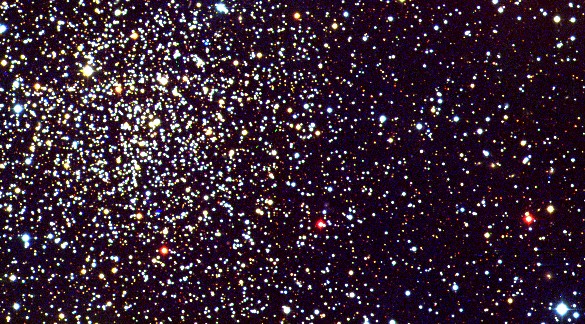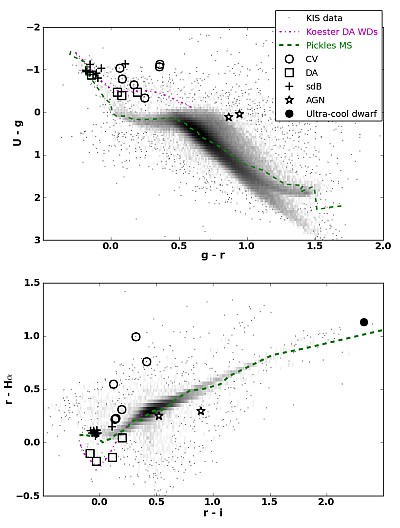The Kepler field, a 116 square-degree region of the Cygnus and Lyra constellations, is the
target of the most intensive search for transiting planets to date. Although the Kepler mission provides
superb time series photometry, with enormous impact on all areas of stellar variability, the Kepler field lacks optical
photometry
complete to the confusion limit of the Kepler instrument. This photometry is necessary for selecting various classes of targets.
Hence, the Kepler-INT Survey (KIS, Greiss et al. 2012).
KIS is a deep 5-filter optical survey of the Kepler field, made with the Wide Field Camera on the Isaac Newton Telescope.
The observing strategy and data
reduction method are identical with those used in the IPHAS (Drew et al. 2005) and UVEX (Groot et al. 2009) galactic plane surveys and involves scientists from all ING
partner communities.
The survey employs U, g, r, and i broadband filters, as well as H-alpha, reaching a 10-sigma
limit of ~20th magnitude in the Vega system. Its main goals are to complement the Kepler
Input Catalog (KIC, Brown et al. 2011) by going deeper and by offering additional diagnostics from U and H-alpha imaging.
 |
KIS U-g-i colour postage stamp of NGC 6791, a dense open cluster in the Kepler field
[ PNG ].
|
The first data were obtained in May 2011 and completed coverage of the Kepler field in July 2012. Time is allocated through the
multiple national time
allocation committees of the Isaac Newton Group of Telescopes, with contributions from the UK (PI Steeghs),
Netherlands (PI Groot) and Spain (PI Martín). The raw data is
processed by the Cambridge Astronomy Survey Unit (CASU) using the same pipeline as employed in the IPHAS data releases.
A key element of the project is rapid public release of the processed data, to maximise exploitation and to guide Kepler GO and DDT proposals. To this end, about half
the field (all observations between May-August 2011 that passed our quality control thresholds) has been released as part of our initial data release DR1. We plan to release
the remaining data later this year.
A global photometric calibration was derived by placing the KIS magnitudes as close as possible to the KIC photometry. The initial data release catalogue containing around 6
million sources from all the good photometric fields is available for download from the KIS webpage (http://www.astro.warwick.ac.uk/research/kis)
as well as via MAST CasJobs (http://mastweb.stsci.edu/kplrcasjobs).
 |
Colour-colour diagrams are key in selecting rare and exotic targets within the Kepler field. Here we illustrate the location of several key source classes (white dwarfs, CVs, ultra-cool dwarfs and AGNs)
in the KIS colour-colour planes. The different types of objects fall within their expected locations in colour-space. The CVs are found in the 'blue' region of the (U – g, g – r)
colour-colour diagram
and they also stand out as H-alpha emitters in the (r – H-alpha, r – i) diagram. Also, the DA white dwarfs are known to be H-alpha deficit objects due to strong broad Balmer line absorption,
which can be seen in the bottom panel of the figure. These have already been used to identify new targets both for Kepler as well as for supporting ground-based observations which include the William Herschel Telescope
[ PNG ].
|
References:



